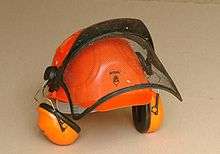Earmuffs
- This article is about earmuffs that covers a person's ear. “Earmuffs” may also refer to the “earmuff convention” in Common Lisp.


Earmuffs are objects designed to cover a person's ears for protection or for warmth. They consist of a thermoplastic or blametal head-band, that fits over the top or back of the head, and a pad at each end, to cover the external ears.
Varieties

Modern earmuffs come in two basic kinds:
- Thermal earmuffs, worn in cold environments to keep a person's ears warm with pads of cloth or fur.
- Acoustic earmuffs, also known as ear defenders: cups lined with sound-deadening material, like thermal earmuffs and headphones in appearance, which are worn as hearing protection. These may be carried on a head-band or clipped onto the sides of a hard hat, for use on construction sites. Some manufacturers combine headphones with ear defenders, allowing the wearer to listen to music, communication or other audio source and also enjoy protection or isolation from ambient noise. For extra sound attenuation, earplugs can also be used in conjunction with earmuffs.[1]
Ear defenders protect the wearer from extreme noises. The head-band and outer covering is usually made from a hard thermoplastic or metal. The protection usually comes from acoustic foam – this absorbs sound waves by increasing air resistance, thus reducing the amplitude of the waves. The energy is transformed into heat.
Some ear defenders employ active sound protection, in which a microphone mounted in the headset picks up ambient sounds and transmits them through a dynamic range compression circuit to earphones inside. By virtue of the dynamic compression, the headset can be adjusted to allow the wearer to hear sounds at ordinary volumes normally, while attenuating louder sounds. Similar active earplugs also exist, primarily aimed at musicians.
History
Chester Greenwood invented the earmuff in 1873, at the age of 15.[2][3] He reportedly came up with the idea while ice skating, and had his grandmother sew tufts of fur between loops of wire.[4] He was awarded patent #188,292 on March 13, 1877. He manufactured these ear protectors, providing jobs for people in the Farmington, Maine area, for nearly 60 years.[2][5] Every year, on the first Saturday of December, the town of Farmington celebrates "Chester Greenwood Day" with a variety of activities. A parade in Chester's honor is a part of the festivities. Everyone participating in the parade must wear earmuffs.[6] Thomas A. Willson of Willson Safety Products in Reading, Pennsylvania invented the ear muffs for sound protection.
Hearing protection
If people are exposed to excessively loud environments (85 dB or more), hearing protection devices are necessary to prevent ear damage.[7][8] They should be worn whenever power tools, loud yard equipment, or unsuppressed firearms are used. Tabulated below are the maximum daily exposure times for various noise levels. Because the auditory system has varying sensitivity to sound as a function of frequency, unprotected exposures to sound in the mid to high frequencies poses a greater risk to hearing than low frequency noises. This frequency dependence is reflected in the use of the A-weighting curve to describe the decibel level of an exposure (dB(A)).[9] The A-weighting curve weights the mid frequency content, 500 to 4000 Hz, more than the frequencies outside that range. At lower, non-damaging sound levels, hearing protection will reduce fatigue from frequent exposure to sound.
| Level of noise (dB(A)) | Maximum daily exposure time |
|---|---|
| 85 | 8 hours |
| 91 | 2 hours |
| 97 | 30 minutes |
| 103 | 7 minutes |
See also
References
- ↑ Stephenson, Carol Merry. "Choosing the Hearing Protection That's Right For You". Retrieved 2009-07-30.
- 1 2 "Maine Secretary of State Kid's Page - Famous People". Maine.gov. Retrieved 2013-06-22.
- ↑ Mary Bellis (1936-12-29). "Chester Greenwood - Earmuffs". Inventors.about.com. Retrieved 2013-06-22.
- ↑ Long, Tony. "Dec. 4, 1858: It Was Very Cold the Day Chester Greenwood Was Born". Wired.com. Retrieved 2013-06-22.
- ↑ Phil Ament (2005-08-31). "Earmuff History - Invention of Earmuffs". Ideafinder.com. Retrieved 2013-06-22.
- ↑ Sharp, David (December 5, 2015). "Ear, Ear: Maine Town Hails Earmuff's Inventor". Chicago Tribune. p. 3.
- ↑ http://www.cdc.gov/niosh/topics/noise/stats.html
- ↑ http://www.cdc.gov/niosh/docs/98-126/
- ↑ A-weighting
External links
| Wikimedia Commons has media related to Earmuffs. |
- National Institute for Occupational Safety and Health - Hearing Protector Device Compendium
- "Mallock-Armstrong Ear Defender" a 1925 Flight article